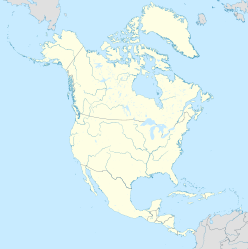Chicxulub crater
| Chicxulub impact structure | |
 | |
| Impact crater/structure | |
|---|---|
| Confidence | Confirmed |
| Diameter | 180 km (110 mi) |
| Depth | 20 km (12 mi) |
| Impactor diameter | 10 kilometers (6.2 mi) |
| Age | 66.043 ± 0.043 Ma Cretaceous–Eoceneboundary[2] |
| Exposed | No |
| Drilled | Yes |
| Bolidetype | CMorCRtypecarbonaceous chondrite |
| Location | |
| Coordinates | 21°24′0″N89°31′0″W/ 21.40000°N 89.51667°W |
| Country | Mexico |
| State | Yucatán |
TheChicxulub crateris a largemeteoritecrater.It was probably made by themeteorthat caused theextinctionof thedinosaursand other animals ~65mya.It is partly in theYucatán PeninsulainMexicoand partly underwater.
The Chicxulub crater is more than 180 km (110 mi) in diameter, making it the third largest confirmedimpact crateron Earth.[3]Petroleumprospectors found it in the late 1970s.
Thebolidewhich formed the crater was at least 10 km (6 mi) in diameter. Evidence for the impact origin of the crater includes shockedquartz,agravityanomaly, andtektitesin surrounding areas. The age of the rocks andisotopeanalysis show that this impact structure dates from the end of theCretaceousperiod, roughly 66 million years ago. The impact which caused the crater probably caused theCretaceous–Tertiary extinction event.
In March 2010, following analysis of the availableevidencecovering 20 years' worth of data in the fields ofpalaeontology,geochemistry,climatemodelling, geophysicsandsedimentology,41 international experts from 33 institutions reviewed available evidence. They said the impact at Chicxulubtriggeredthe mass extinctions during the K-T boundary, including that of dinosaurs.[4][5]
Scientists can now describe in detail how the asteroid that wiped out the dinosaurs produced its huge crater.[6]The reconstruction of the event 66 million years ago was made possible by drilling into the remnant bowl and analysing its rocks.
Evidence of impact
[change|change source]Scientists have found evidence of fallout from the asteroid impact. Excavations inNorth Dakotareveal fossils of fish and trees that were sprayed with rocky, glassy fragments that fell from the sky. The deposits also show evidence of being swamped with water. This was caused by the colossal sea surge caused by the impact.[7]
Related pages
[change|change source]References
[change|change source]- ↑"PIA03379: Shaded Relief with Height as Color, Yucatan Peninsula, Mexico".Shuttle Radar Topography Mission.NASA.Archivedfrom the original on March 13, 2017.RetrievedOctober 28,2010.
- ↑Renne, P. R.; Deino, A. L.; Hilgen, F. J.; Kuiper, K. F.; Mark, D. F.; Mitchell, W. S.; Morgan, L. E.; Mundil, R.; Smit, J. (2013)."Time Scales of Critical Events Around the Cretaceous-Paleogene Boundary"(PDF).Science.339(6120): 684–687.Bibcode:2013Sci...339..684R.doi:10.1126/science.1230492.ISSN0036-8075.PMID23393261.S2CID6112274.Archived(PDF)from the original on April 3, 2018.RetrievedJuly 28,2017.
- ↑Earth Impact Data Base
- ↑Schulte, Peter; et al. (2010)."The Chicxulub asteroid impact and mass extinction at the Cretaceous–Paleogene boundary".Science.327(5970). AAAS: 1214–1218.Bibcode:2010Sci...327.1214S.doi:10.1126/science.1177265.ISSN1095-9203.PMID20203042.S2CID2659741.Retrieved5 March2010.
- ↑Rincon, Paul (2010-03-04)."Dinosaur extinction link to crater confirmed".BBC.Retrieved2010-03-05.
- ↑Amos, Jonathan 2019. Asteroid strike made 'instant Himalayas'.BBC NewsScience & Environment.[1]
- ↑Amos, Jonathan 2019. Chicxulub asteroid impact: stunning fossils record dinosaurs' demise.BBC News& Environment.[2]


